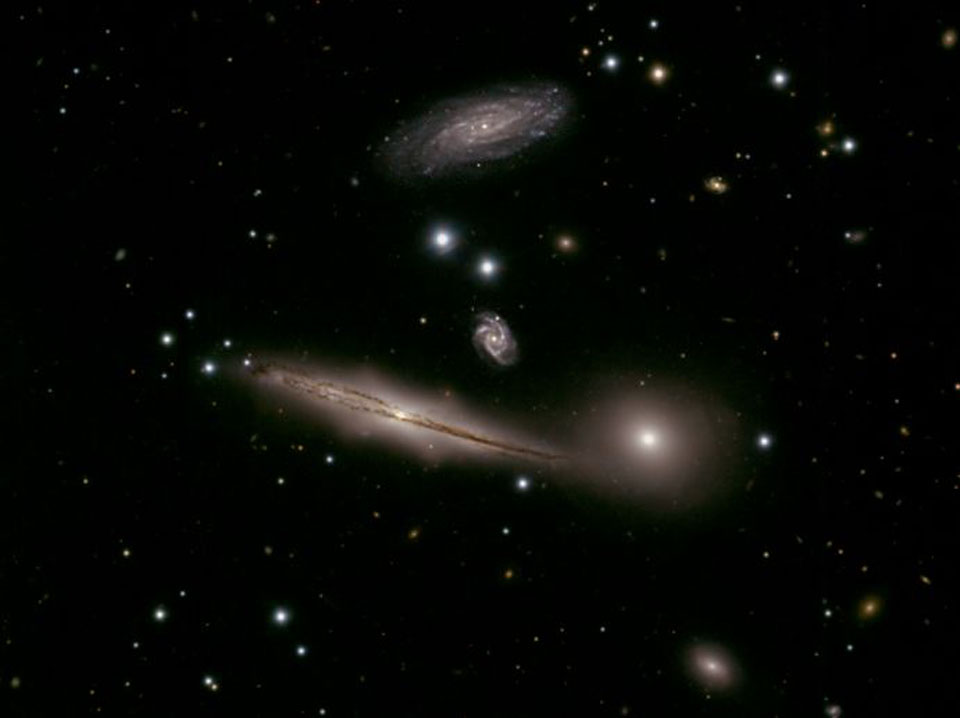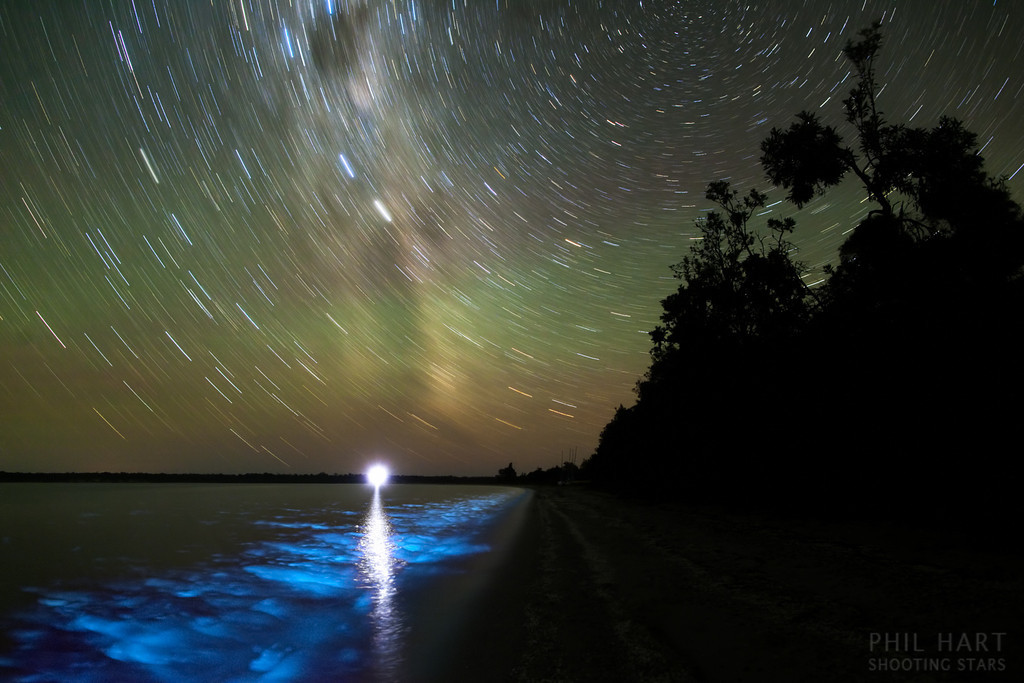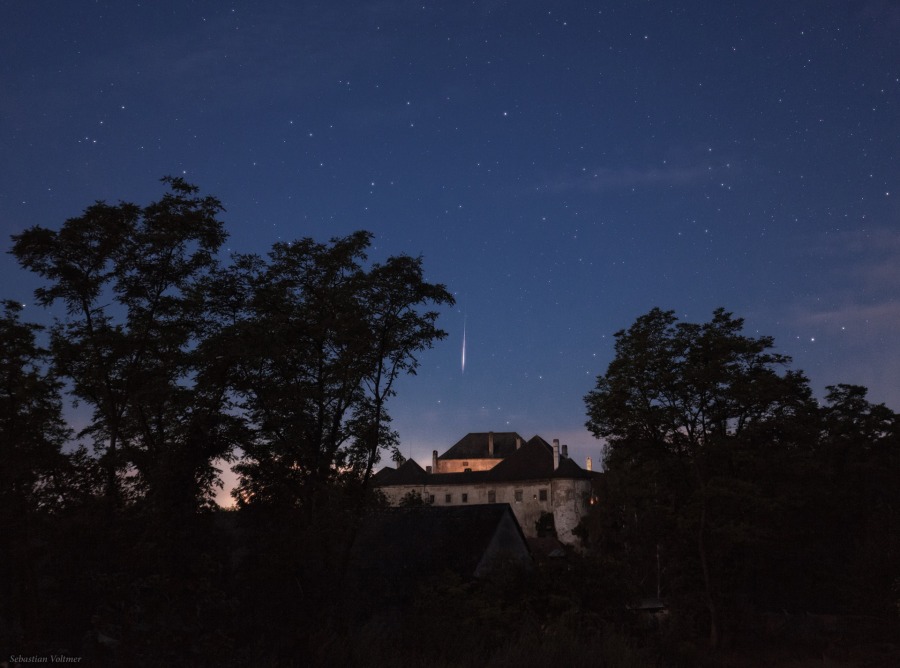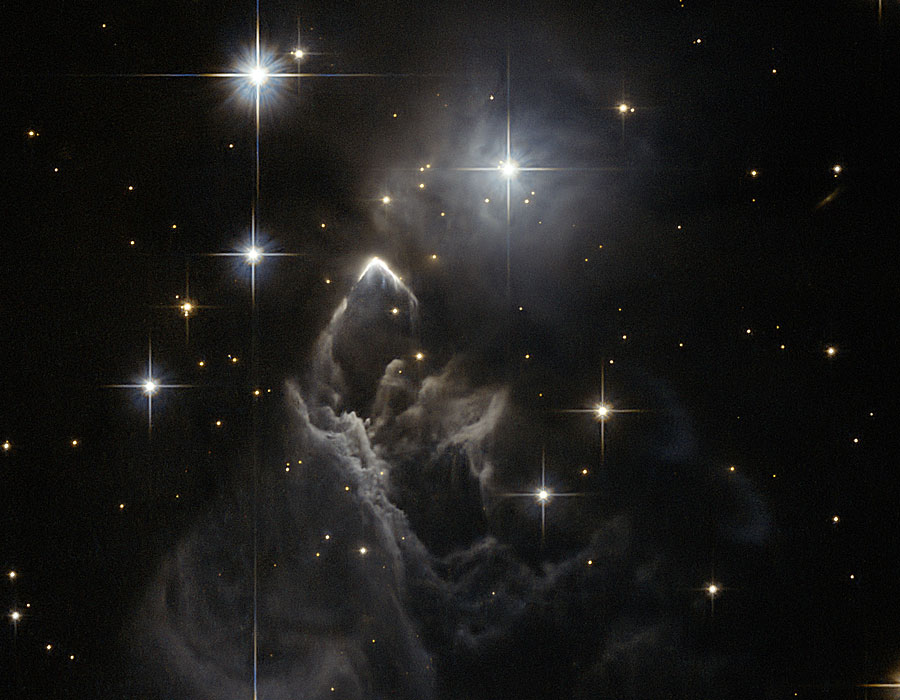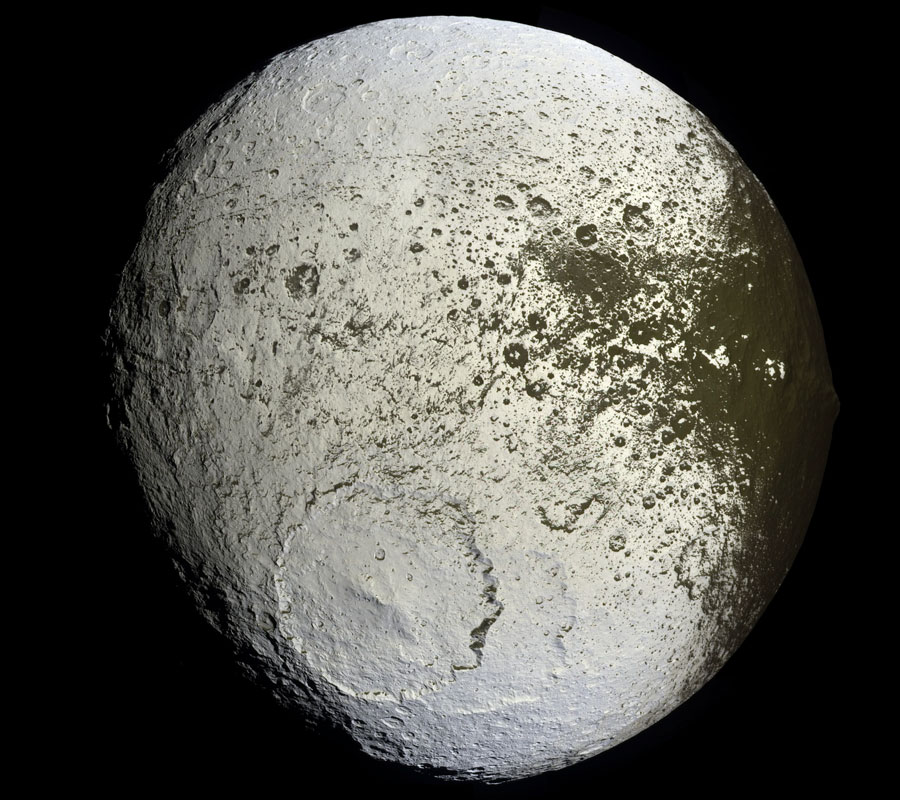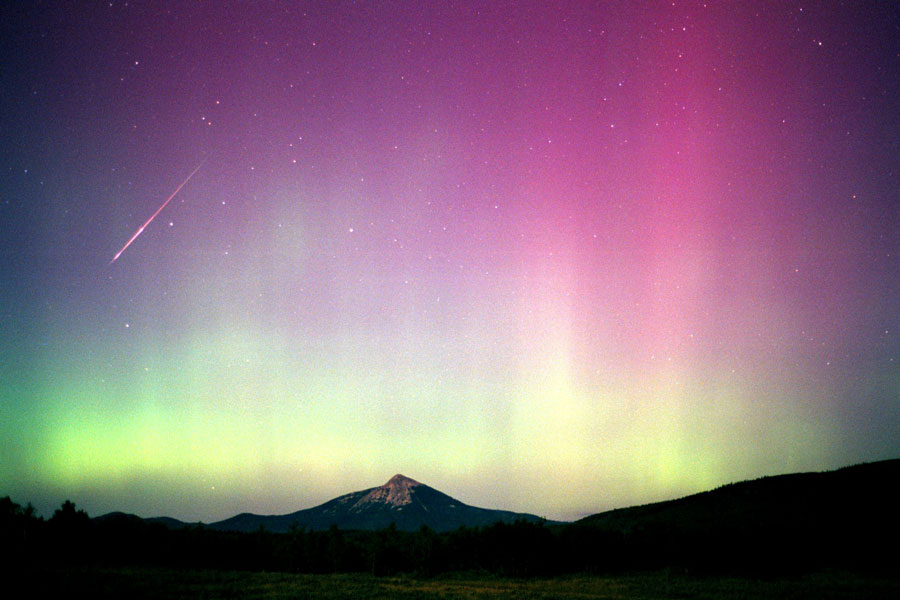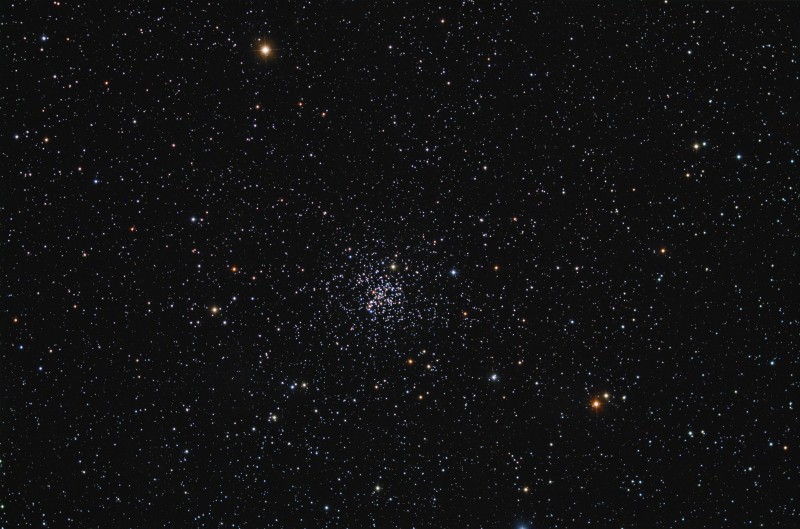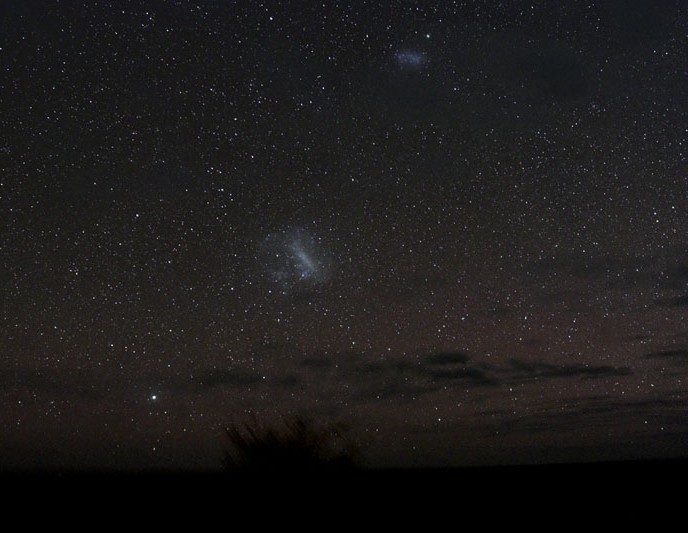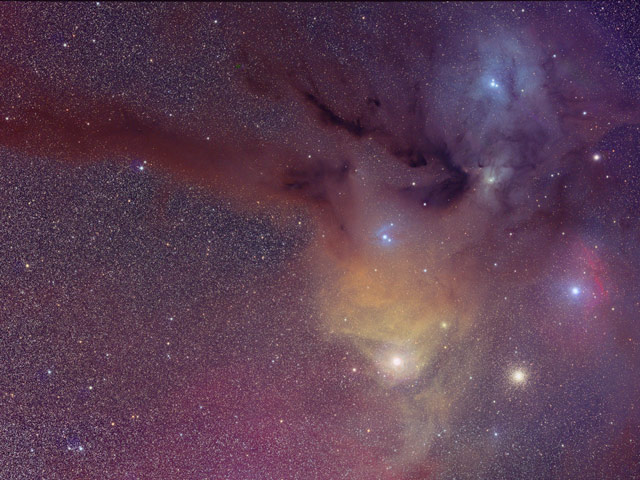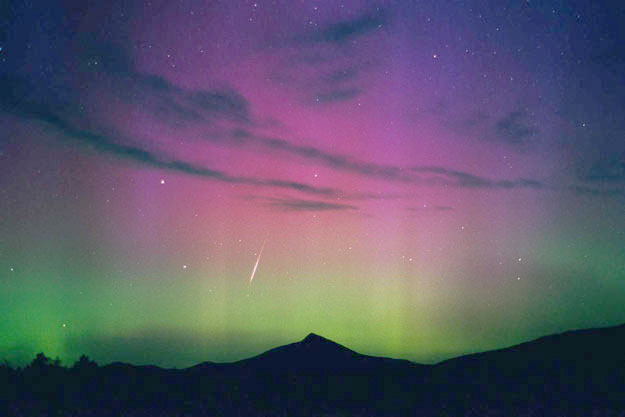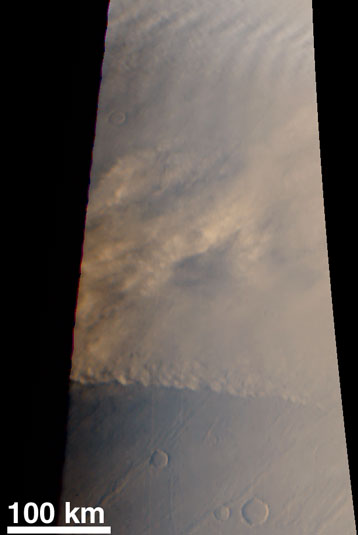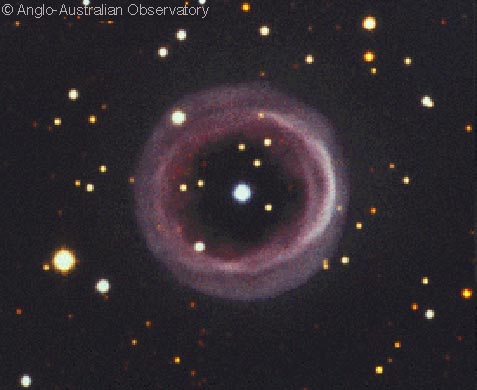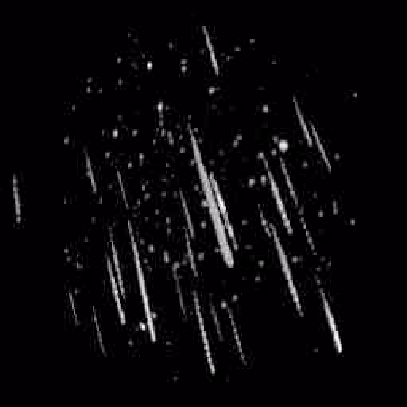| << Previous | Index | Next >> |
2015 Sometimes galaxies form groups. For example, our own Milky Way Galaxy is part of the Local Group of Galaxies. Small, compact groups, like Hickson Compact Group 87 (HCG 87) shown above, are interesting partly because they slowly self-destruct. Indeed, the galaxies of HCG 87 are gravitationally stretching each other during their 100-million year orbits around a common center. The pulling creates colliding gas that causes bright bursts of star formation and feeds matter into their active galaxy centers. HCG 87 is composed of a large edge-on spiral galaxy visible near the image center, an elliptical galaxy visible to its right, and a spiral galaxy visible near the top. The small spiral near the center might be far in the distance. Several stars from our Galaxy are also visible in the foreground. Studying groups like HCG 87 allows insight into how all galaxies form and evolve.
2014 What shines in the world at night? Just visible to the eye, a rare electric blue glow spread along the shores of Victoria Lake on January 16, 2013. Against reflections of a light near the horizon, this digitally stacked long exposure recorded the bioluminescence of Noctiluca scintillans, plankton stimulated by the lapping waves. Above, the night skies of the Gippsland Lakes region, Victoria, Australia shine with a fainter greenish airglow. Oxygen atoms in the upper atmosphere, initially excited by ultraviolet sunlight, produce the more widely seen fading atmospheric chemiluminescence. Washed out by the Earth's rotation, the faint band of the southern summer Milky Way stretches from the horizon as star trails circle the South Celestial Pole.
2013 Medieval Albrechtsberg castle is nestled in trees near the northern bank of the river Pielach and the town of Melk, Austria. In clearing night skies on August 12, 2012 it stood under constellations of the northern summer, including Aquarius, Aquila, and faint, compact Delphinus (above and right of center) in this west-looking skyview. The scene also captures a bright meteor above the castle walls. Part of the annual perseid meteor shower, its trail points back toward the heroic constellation Perseus high above the horizon in the early morning hours. Entering the atmosphere at about 60 kilometers per second, perseid meteors are swept up dust grains from the tail of comet Swift-Tuttle. Of course, this year's perseid meteors will flash through night skies this weekend.
2012
[imghover6=http://apod.nasa.gov/apod/image/1208/Ma ... zel900.jpg]http://apod.nasa.gov/apod/image/1208/Ma ... _La900.jpg[/imghover6]Image Credit & Copyright: Cenk E. Tezel, Tunç Tezel (TWAN)
2011
Click to play embedded YouTube video.
Video Credit: NASA
2010 What's lighting up nebula IRAS 05437+2502? No one is sure. Particularly enigmatic is the bright upside-down V that defines the upper edge of this floating mountain of interstellar dust, visible near the image center. In general, this ghost-like nebula involves a small star forming region filled with dark dust that was first noted in images taken by the IRAS satellite in infrared light in 1983. Shown above is a spectacular, recently released image from the Hubble Space Telescope that, although showing many new details, has not uncovered a clear cause of the bright sharp arc. One hypothesis holds that the glowing arc was created by a massive star that somehow attained a high velocity and has now left the nebula. Small, faint IRAS 05437+2502 spans only 1/18th of a full moon toward the constellation of the Bull (Taurus).
2009 What has happened to Saturn's moon Iapetus? Vast sections of this strange world are dark as coal, while others are as bright as ice. The composition of the dark material is unknown, but infrared spectra indicate that it possibly contains some dark form of carbon. Iapetus also has an unusual equatorial ridge that makes it appear like a walnut. To help better understand this seemingly painted moon, NASA directed the robotic Cassini spacecraft orbiting Saturn to swoop within 2,000 kilometers in 2007. Pictured above, from about 75,000 kilometers out, Cassini's trajectory allowed unprecedented imaging of the hemisphere of Iapetus that is always trailing. A huge impact crater seen in the south spans a tremendous 450 kilometers and appears superposed on an older crater of similar size. The dark material is seen increasingly coating the easternmost part of Iapetus, darkening craters and highlands alike. Close inspection indicates that the dark coating typically faces the moon's equator and is less than a meter thick. A leading hypothesis is that the dark material is mostly dirt leftover when relatively warm but dirty ice sublimates. An initial coating of dark material may have been effectively painted on by the accretion of meteor-liberated debris from other moons. This and other images from Cassini's Iapetus flyby are being studied for even greater clues.
2008 Dark skies are favored for viewing meteor showers -- so the best viewing of this year's Perseids will occur in the early morning. While the Perseid meteor shower is scheduled to peak over the next few days, bright light from a gibbous Moon will also flood the early evening and mask the majority of relatively faint meteors. Still, skygazing in the early morning after the Moon sets (after about 2 AM local time) could reveal many faint meteors. Persistant observing at any time after sunset can reward northern hemisphere watchers looking for occasional Perseid fireballs. Astronomer Jimmy Westlake imaged this bright Perseid meteor despite the combination of moonlight and auroral glow over Colorado skies in August of 2000.
2007 Gathered at the center of this sharp skyview are the stars of Messier 67, one of the oldest known open star clusters. In fact, though open star clusters are usually much younger, the stars of M67 are likely around 4 billion years old, about the same age and with about the same elemental abundances as the Sun. Open clusters are almost always younger because they are dispersed over time as they encounter other stars, interstellar clouds, and experience gravitational tides while orbiting the center of our galaxy. Still, M67 contains over 500 stars or so and lies some 2,800 light-years away in the constellation Cancer. At that estimated distance, M67 would be about 12 light-years across.
2006 This early morning skyscape recorded near Winton, Queensland, Australia, looks toward the southeast. Low clouds are seen in silhouette against the first hints of sunlight, while two famous cosmic clouds, the Clouds of Magellan, also hover in the brightening sky. The Small Magellanic Cloud (SMC, upper right), and the Large Magellanic Cloud (LMC) are prominent wonders of the southern sky, named for the 16th century Portuguese explorer Ferdinand Magellan. They are small, irregular galaxies in their own right, satellites of our much larger, spiral Milky Way galaxy. The SMC is about 210,000 light-years and the LMC about 180,000 light-years away. At lower left, bright star Canopus (Alpha Carinae), denizen of the Milky Way, is a mere 310 light-years distant.
2005 Although you've surely seen it, you might not have noticed it. During a cloudless twilight, just before sunrise or after sunset, part of the atmosphere above the horizon appears slightly off-color, slightly pink. Called the Belt of Venus, this off-color band between the dark eclipsed sky and the blue sky can be seen in nearly every direction including that opposite the Sun. Straight above, blue sky is normal sunlight reflecting off the atmosphere. In the Belt of Venus, however, the atmosphere reflects light from the setting (or rising) Sun which appears more red. The Belt of Venus can be seen from any location with a clear horizon. Pictured above, the Belt of Venus was photographed behind Elwood Beach in Melbourne, Australia. The belt is frequently caught by accident in other photographs.
2004 Connecting the Pipe Nebula to the bright star Antares is a flowing dark cloud nicknamed the Dark River. The murkiness of the Dark River is caused by absorption of background starlight by dust, although the nebula contains mostly hydrogen and molecular gas. Antares, the brightest star in the frame, is embedded in the colorful Rho Ophiuchi nebula clouds. The Dark River, pictured above across the upper left, spans over 20 times the angular diameter of the Moon and lies about 500 light years distant. Other types of nebula visible here include red emission nebula and the blue reflection nebula.
2003 Just after the Moon set but before the Sun rose in the early morning hours of 2000 August 12, meteors pelted the Earth from the direction of the constellation Perseus, while ions pelted the Earth from the Sun. The meteors were expected as sub-sand grains long left behind by Comet Swift-Tuttle annually create the Perseids Meteor Shower. The aurorae were unexpected, however, as electrons, protons, and heavier ions raced out from a large Coronal Mass Ejection that had occurred just days before on the Sun. In the foreground is Hahn's Peak, an extinct volcano in Colorado, USA. The Perseid meteor shower peaks this year over the next few days, with as much as one bright meteor per minute visible from some locations.
2002 Experimenting with a new telescope and camera, photographer Jim Steele captured this surreal but festive image of fireworks in the night sky above Ashland, Oregon. The date was July 4th and the fiery streaks were part of the traditional annual celebration of independence day in the United States. Fiery streaks from another annual event will revisit dark skies this weekend, as shooting stars arc through the night during the much anticipated Perseid Meteor Shower. Perseid meteors are actually bits of dust from the periodic Comet Swift-Tuttle and once each year planet Earth orbits through Swift-Tuttle's cometary dust stream. As the comet dust enters Earth's atmosphere traveling at tens of kilometers per second, the particles are vaporized leaving bright and sometimes colorful trails. While Perseid meteors can be viewed over the next few nights, this year's shower is expected to peak on August 12 and 13 with a rate of dozens or more meteors per hour visible in moonless early morning skies.
2001 Dazzling in binoculars or a small telescope, the Moon is pocked with impact craters. During partial lunar phases, the craters along the terminator are cast in dramatic relief by strong shadows. But when the Moon is full some craters seem to sprout systems of bright radial lines or rays. This detailed digital close-up of the full Moon features two prominent ray craters, Copernicus (upper left) and Tycho (lower right), each with extensive ray systems of light colored debris blasted out by the crater-forming impacts. In general, ray craters are relatively young as their rays overlay the lunar terrain. In fact, at 85 kilometers wide, Tycho, with its far reaching rays, is the youngest large crater on the nearside. Crater Copernicus, surrounded by dark mare which contrast nicely with its bright rays, is 93 kilometers in diameter.
2000 Hot gas frequently erupts from the Sun. One such eruption produced the glowing filament pictured above, which was captured on July 19 by the Earth-orbiting TRACE satellite. The filament, although small compared to the overall size of the Sun, measures over 100,000 kilometers in height, so that the entire Earth could easily fit into its outstretched arms. Gas in the filament is funneled by the complex and changing magnetic field of the Sun. After lifting off from the Sun's surface, most of the filamentary gas will eventually fall back. More powerful solar eruptions emit particles that reach the Earth and can disrupt manmade satellites. The cause and nature of solar eruptions are the topic of much research.
1999 Batten down the hatches, here comes another Martian dust storm. The thin soil on Mars can be picked up by high winds to create dust storms that sweep down plains and can sometimes envelop most of the planet. The Mars Global Surveyor spacecraft currently orbiting Mars recently photographed such a dust storm raging on Mars' northern plains. The advancing storm front can be seen dividing clear and obscured areas on the photograph on the left. Even away from dust storms, isolated tornado like swirls called dust devils can reach 8-kilometers high and also be created by Martian winds. Studying wind phenomena on Mars provides valuable insight towards understand similar phenomena here on Earth.
1998 What happens when a star runs out of nuclear fuel? The center condenses into a white dwarf while the outer atmospheric layers are expelled into space and appear as a planetary nebula. This particular planetary nebula, designated Shapley 1 after the famous astronomer Harlow Shapley, has a very apparent annular ring like structure. Although some of these nebula appear like planets on the sky (hence their name), they actually surround stars far outside our Solar System.
1997 You are flying through space and come to ... the Hydra Cluster of Galaxies. Listed as Abell 1060, the Hydra Cluster contains well over 100 bright galaxies. Clusters of galaxies are the largest gravitationally-bound objects in the universe. All of the bright extended images in the above picture are galaxies in the Hydra Cluster with the exception of unrelated diffraction crosses centered on bright stars. Several proximate clusters and galaxy groups might together create an even larger entity - a supercluster - but these clumps of matter are not (yet) falling toward each other. In fact, the Hydra cluster is thought to be part of the Hydra-Centaurus Supercluster of galaxies. Similarly, our own Milky Way Galaxy is part of the Local Group of Galaxies which is part of the Virgo Supercluster of Galaxies.
1996 From a radiant point in the constellation of Perseus, Comet Swift-Tuttle presents -- The Perseid Meteor Shower -- coming to your night sky this weekend! A bookish E. C. Herrick of New Haven, Connecticut correctly suspected in 1837 that this meteor shower was an annual event. Indeed it is now known to be a regular August shower caused by the yearly passage of the Earth through the orbiting debri left behind by periodic comet Swift-Tuttle. Since the bits of comet debri are moving along parallel orbits, on entering the atmosphere they leave fiery trails which appear to originate from a common radiant point in the sky, in this case in the constellation of Perseus. Dramatically illustrated in this composite video image made using MOVIE, meteors from the 1994 Perseids streak across the sky framed by the three bright stars of the asterism known as the "Summer Triangle". The image shows bright Perseids recorded that year from August 9 through 14. Here the trails appear nearly parallel as the camera was centered on the sky about 90 degrees from the radiant point. This year, European and North American observers should be able to view the shower near its maximum, about 90 meteors per hour, early Monday morning August 12, but the shower should be enjoyable on clear weekend nights (August 10,11) as well. After midnight is generally the best time for viewing. What's the best way to enjoy a meteor shower? Get a warm jacket and a comfortable lawnchair ... go outside and look up.
1995 Space Shuttle Challenger jumps off the launch pad in 1985 to begin a successful mission. The main purpose of this mission was to test a new space based laboratory named Spacelab 2. Spacelab 2 takes advantage of the effectively weightless conditions in orbit to carry out experiments in areas such as astronomy, physics, life science, materials science, and atmospheric physics. Challenger and her crew were lost in 1986 when a booster failure resulted in the breakup of the vehicle. Previously, Challenger and her crews flew nine successful Space Shuttle missions and made significant contributions to America's scientific growth.
| << Previous | Index | Next >> |
